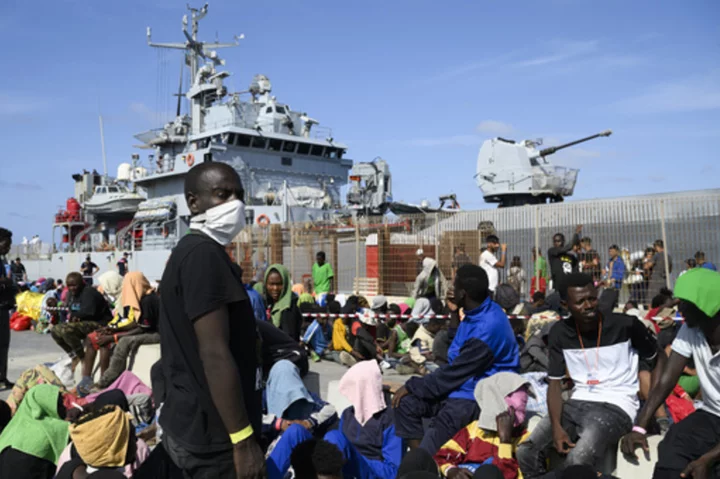BARCELONA, Spain (AP) — Thousands of migrants and refugees have landed on the Italian island of Lampedusa this week after crossing the Mediterranean Sea on small unseaworthy boats from Tunisia, overwhelming local authorities and aid organizations.
Scenes of chaos at an overcrowded reception center in Lampedusa have provoked both solidarity and anger with fingers pointing blame at not just people smugglers, but also Italian Premier Giorgia Meloni, European Union officials and their Tunisian partner, President Kais Saied.
Here's what happened:
HOW MANY MIGRANTS ARRIVED?More than 120 small boats arrived in Lampedusa in the span of roughly 24 hours, bringing the number of people at the local reception center to 7,000 people at one point. That's 15 times its capacity and more than the island's full-time population.
According to Italy's Interior Ministry, more than 127,000 migrants have reached Italy by sea so far this year, nearly double the number for the same period last year.
Lampedusa, which is closer to North Africa than the Italian mainland, has long been targeted by people smugglers. With Tunisia now the main launching pad for Europe, the island today is receiving around 70% of all migrants arriving in Italy, said Flavio Di Giacomo, a spokesperson at the International Organization for Migration's Mediterranean office.
Europe has previously dealt with much higher numbers of daily arrivals, including in the migration crisis of 2015-2016 and most recently after Russia's full-scale invasion of Ukraine. But consecutive arrivals on the small island in a short period of time made things difficult to manage, Di Giacomo said.
The newly arrived migrants are progressively being transferred onto the mainland, where their asylum requests will be processed. Many hope to continue to other parts of Europe to find work or reunite with relatives.
WHO ARE THE PEOPLE ARRIVING?Aboard the boats arriving in Lampedusa from Tunisia are citizens of various African nations, including Ivory Coast, Guinea, Cameroon, Burkina Faso, Mali and Tunisians themselves. Many lived and worked in Tunisia for years before deciding to set off to Europe.
There is also a growing number of people arriving from Tunisia after crossing in from neighboring Libya, according to IOM. These include citizens of Egypt, Eritrea and Sudan, where the ongoing conflict between rival military leaders has already displaced more than 4 million people since April.
Most of those boarding smugglers' boats for Europe are young men and unaccompanied minors, though women and children are seen but in smaller numbers.
WHAT IS BEHIND THE SURGE?Migration experts say Mediterranean storm Daniel forced smugglers in and around the Tunisian coastal city of Sfax to pause their operations for several days, creating a bottleneck. As soon as the weather improved, they launched more than 100 small iron boats from Tunisian beaches carrying between 30 to 40 people.
“It's also a way of making sure more people get through the net and overwhelm the system,” said Chris Borowski, a senior press officer at the European Border and Coast Guard Agency, also known as Frontex.
The end of summer also brings a rush in boat crossings as migrants try their luck before the harsher fall and winter weather.
But there are other underlying factors too. The socio-economic situation in Tunisia is spiraling with high inflation and a lack of jobs, crippling both Tunisians and foreigners living there.
Growing anti-migrant sentiment in the country fueled by President Saied's remarks earlier this year, particularly against sub-Saharan Africans, have also pushed migrants to cross.
“Many were living in Tunisia and became victims of racial discrimination, causing them to flee,” di Giacomo said.
In July, Tunisian authorities rounded up hundreds of Black migrants and refugees, dropping them in the desert border where dozens of people, including children, died, according to reports by human rights groups, Libyan authorities and migrants themselves.
Still, the high number of arrivals shouldn’t have come as a surprise to Italian officials.
“All indicators in Tunisia and the broader region were showing increased arrivals were going to continue," Tasnim Abderrahim a Tunisian researcher at The Global Initiative Against Transnational Organized Crime, also known by its acronym GI-TOC.
WHAT HAPPENED WITH THE TUNISIAN DEAL?As migrant crossings from Tunisia surged, Meloni and European Commission President Ursula von der Leyen made multiple visits to the North African nation this year in an effort to close a new deal with the country's increasingly autocratic leader, with much of the focus on stopping migrant crossings.
In a Memorandum of Understanding signed on July 16, the EU announced a wide-ranging partnership that included 105 million euros ($112 million) dedicated to border control.
It's too early to see if the new EU-funded projects in Tunisia — yet to be implemented — will be effective in reducing migration and stabilizing its economy.
So far, "the situation has only gotten worse,” Abderrahim said.
Tunisia also has conflicting priorities. On the one hand, its crumbling economy is in need of investment. On the other, Saied has said he doesn’t want Tunisia to become Europe's border guard.
“It's unrealistic to expect Tunisia to fully block migrant departures,” Abderrahim said. And even if they wanted to, Tunisia's capacity was limited not just to intercept migrants but also to deal with the surging number of bodies washing ashore that have overwhelmed morgues in coastal cities.
Some politicians have accused Tunisia of deliberately allowing smugglers to launch more and more boats to gain leverage in negotiations with Europe. But no evidence of this has been provided so far.
In any case, experts agree that it's unlikely that smugglers go unnoticed as they weld dozens of iron boats in clandestine shipyards before launching them from beaches around Sfax.
Migrants pay smugglers between 1,500 and 5,000 Tunisian dinars (roughly $500-$1,600) for a spot on the dangerous boats. But demand is growing despite the risk, and not just for Italy. Spain and Greece are also seeing an increase in migrant crossings this year.
Despite Europe's hardening migration policies and improving surveillance technology, smuggling networks across the Mediterranean have demonstrated how quickly they can adapt.
___
Frances D'Emilio contributed to this report from Rome.
___
Follow AP’s coverage of global migration at https://apnews.com/hub/migration









